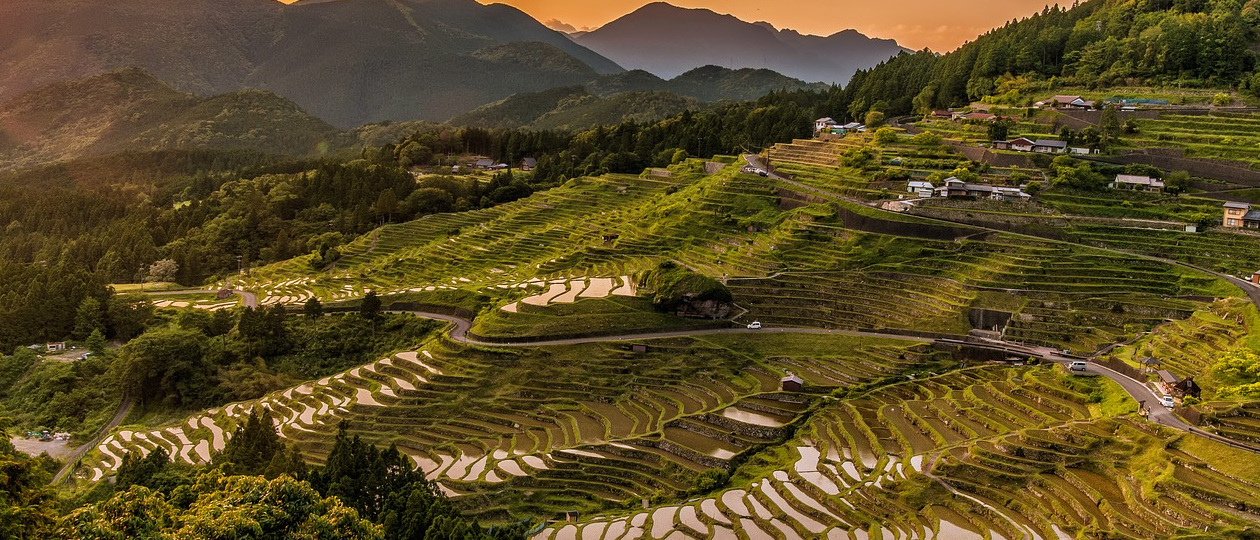
In Shinto, heaven, earth, and humanity are different manifestations of one life energy.
In recent years there has been much talk of climate change and the disastrous consequences of human impact on the environment. We are constantly urged to limit our consumption of fossil fuels and live more respectfully with nature. This practical task of responding to the ecological crisis is given an ethical underpinning by Shinto, which from ancient times has seen it as the principal duty of human beings to care for and preserve their environment — to live within nature rather than attempting to dominate or destroy it.
From earliest times, Japan has endeavored to preserve and nurture its abundant forests. Yet at times of upheaval and change, the forests have been damaged recklessly. Whenever this has happened, Shinto leaders have been at the forefront of campaigns to restore the forests, recognizing that they are the lungs of the nation and indeed the world. Japan suffered a tremendous loss of trees in the aftermath of World War II. This damage reflected the trauma of the people and the shift from spiritual toward materialistic values. Yet the importance of the forest, at both psychic and ecological levels, was understood by the Showa Emperor, who threw part of his personal fortune behind an appeal for reforestation. The people responded well and saw it as their task to restore the image of their country as a landscape of green mountains. As a result, with 9,600,000 hectares, Japan now ranks third on the list of most successfully reforested countries in the world.
Water will continue to run from mountain springs as long as we keep the forests intact. People in the West are now ready to see the world as Gaia, the ancient Greek goddess of the earth, a living organism, all parts of which are connected to and dependent upon each other. And as with other living organisms, when one part is injured or out of control, the whole loses its balance and becomes sick. When the earth becomes sick, we are obliged to use our knowledge and power to restore it.
An outward expression of Shinto’s concern for the health of nature can be seen in the forested areas surrounding Shinto shrines. For more than three thousand years, the Japanese have believed that Kami, the powers of the spiritual dimension, can make contact with human beings through trees. We can therefore also find sacred trees within the precincts of certain Shinto shrines. Some of these trees are more than four thousand years old. A sense of the sacred in trees, and a desire to nurture them, is profoundly rooted in the spirituality of Japan.
Here we can find in Shinto a universal meaning and a practical ethos for today’s world. It can attune us to see the connection between the well-being of the natural world and our own spiritual well-being. In the ancient wisdom of Japan, we can find a missing link that restores our awareness of nature, and so give us the wholeness we crave for in a world dominated by material and mechanical notions of progress. In the present practice of tree planting and arboriculture, we find a modern expression of an age-old spiritual sensibility.
Shinto is an authentic, indigenous spiritual tradition of the Japanese people. Many of its outward forms and practices are therefore specific to Japan, but its essence is valid for all of humanity and very relevant to us in our present predicament. Shinto’s understanding of the intrinsic value of the natural world is linked to an emphasis on purification, which has a dual physical and spiritual significance. At the core of the Shinto tradition is the practice of immersing the body in water. Whilst this ritual is one of physical cleansing — the purification of the body — it also represents the purification of the mind and spirit. It reminds us of the significance of water as the source of life, without which no life can be sustained.
In our urbanized culture, nature is often treated as if it were a mere wilderness, an occasional refuge for us perhaps, but not of central importance to our lives. The return of the idea of Gaia is a radical challenge to this way of looking at the world. It reminds us that we are part of nature, rather than above or beyond it. The water with which we purify ourselves is, after all, the first ingredient of the human organism. Gaia was entrusted with the preservation of nature’s balance. She has living counterparts in Shinto-Kunitokotachi no kami and Toyouke-hime no kami; the Kami of natural energy. Every creature comes into existence as if it is generated by its respect for the Kami of nature. Since these two Kami hide their presence behind their innumerable offspring, they are known as the invisible Kami. Yet theirs are the threads that hold together the great web of life.





